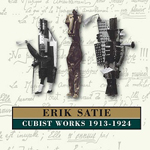|
|
 |
Dusted Reviews
Artist: Erik Satie Album: Cubist Works 1913-1924 Label: LTM Review date: Jun. 20, 2007 |

|
|
|
 |
The idea of art forms developing at different rates is nothing new. Harmony Korine has famously described filmmaking as a partial birth: a leg has slid out from the womb, but the rest is still being birthed, painfully slowly. Cubist Works 1913-1924 is British label LTM’s latest in a series of themed releases revolving around oddball French composer Erik Satie’s engagements with a range of his era’s avant-garde currents: thus far, they’ve covered everything from his involvement with the Rosicrucians (Musique de la Rose+Croix/Pages Mystiques/Uspud) to Dada (Dada Works & Entr’Actes). As Korine’s films implicitly acknowledge the formal experimentation undertaken in novel writing without attempting to reproduce it, Cubist Works shows the artist less concerned with playing catch-up with the innovations of other media – in this case, painting after photography – than unpacking its implications for his own work.
The 11-year period covered by the disc is not the one Satie is best known for, but focusing on this period helps dispel the myth of Satie as an insular, ‘absolutely’ original artist, emphasizing rather his theremin-like relationship to the artistic and social splintering of the first world war and its aftermath. The album collects Satie’s 1917 and 1924 collaborations with Pablo Picasso, the Cubist ballets Parade and Mercure, presented here in both solo piano and full orchestral arrangements, as well as two lesser-known incidental pieces.
Of course, it’s difficult to evaluate these pieces in the context of Satie’s oeuvre without their visual accompaniment. According to James Hayward’s excellent liner notes, Satie intended his music for the short ballet Mercure, his second collaboration with Picasso, to be a musical translation of the latter’s work on costumes, décor, and scenario. The inclusion of “Trois Valses distinguées du précieux dégoûté,” a parody of Maurice Ravel’s stately treacle, may have come across as ephemera were it not followed by the “Prélude du Rideau rouge” from Parade. The ascending, pompous piano coda that concludes the former returns as a motif in the latter, this time as a club-footed monster whose rhythmic slippages make Captain Beefheart thinkable. The suggestion is an important one, as it complicates this collection’s thesis by portraying a cannibalistic Satie feeding off and transmuting art he despises while encountering cubism just as critically and voraciously.
Erik Satie's schizophrenic body of work has resisted canonization by the classical establishment in favor of avant-garde adulation and popular ubiquity: by turns, he’s either Vexations, paving the way for aleatory and process music, or he’s the superb, cinematic mood music of Gymnopédies. In the vacillation between these poles, we find the notion of "Furniture Music," which, as Brian Eno would articulate much later, is as excellent as it is ignorable. By drawing out the explicit links between Satie’s work and the frenetic, sectarian art world of Paris in the late 19th and early 20th centuries, LTM has done a great service to Satie’s legacy, allowing the listener to index just how much Satie was both of and ahead of his time.
By Brandon Bussolini
|







